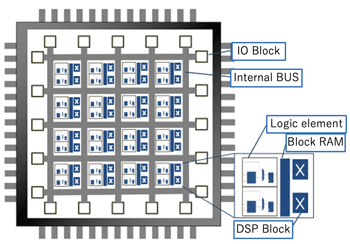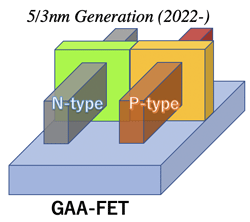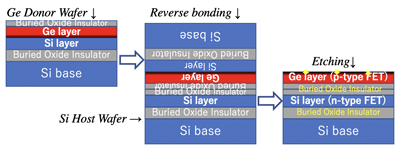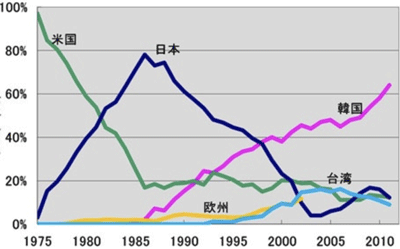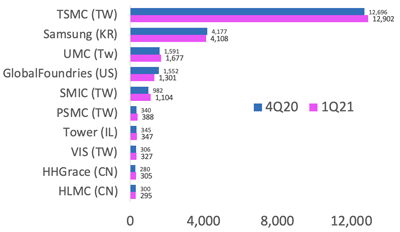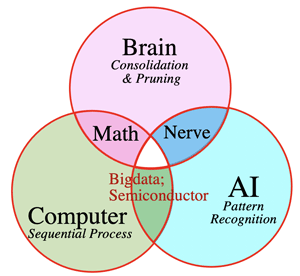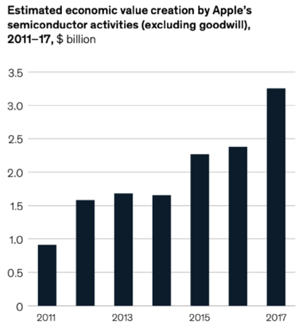>Top 9. AI-related Semiconductors:
- AI-related semiconductors:
- AI-related semiconductors to grow more than $30B by 2022 (CAGR 50%).
- Semiconductors power inference systems such as facial recognition, robotics, factory automation, autonomous driving and surveillance.
- In comparison, training systems will be primarily based on traditional CPU, GPU, FPGA and ASIC.
- The sales of semiconductor totaled $481B in 2018, and is expected to 575B (4.6% growth)
- 7 component types will maintain the largest share of semiconductor revenues: memory, logic, micro-component, analog, OSD (optoelectronic, sensor, and discrete).
- Automotive market will grow the fastest with CAGR 11.9%; such as ADAS (Advanced driver-assistance system, LiDAR (Light detection and ranging), infotainment and safety & convenience functions.
- Communications: CAGR 2.2%; 80% of the demand is driven by phones. Introduction of 5G continues high replacement rates of smartphones.
- Consumer electronics: 4K TV, 3D programming, Video-on-demand content, large display, gaming grow at CAGR of 2.2%. Wearables market grows the fastest at CAGR 6%.
- Data processing: PC, ultra-mobiles, tablets, servers and storage devices will grow at CAGR 2.1%.; storage device with CAGR 12.3%.
- Industrial: CAGR 10.8% through 2022. Demand for security, automation, solid-state lighting and transportation.
- Market growth by region:
- Asia-Pacific region:
- main contributor of revenues with CAGR 4.8%.
- China is the world's largest purchaser of semiconductors, and strengthening the industry with many early startup companies.
- The Americas region:
- second highest CAGR 4.3%.
- US has a number of leading semiconductor companies and has strong startup ecosystem.
- US government vetoed acquisition plans from non-US companies.
- EMEA region:
- CAGR 3.5%
- Europe has leading companies like automotive, mobility (rail, air) and engineering.
- EU promotes and protect its semiconductor industry.
- >Top Training system and Inference system:
- Training systems: leverage massive data sets to learn how to carry out specific activities and to evolve the learning algorithm.
- Inference systems: make mealtime decisions using predefined models.
- >Top AI Technology Stack: (PWC)
- Applications & Services:
- Vision processing, Chat bots, Smart assistants, Algorithmic trading
- AI Platforms:
- Machine learning, Data analytics, NLP (Natural Language Processing), Agents, Data solutions to build AI applications
- AI FTI (Frameworks, Tools & Interfaces):
- ML algorithms to design, build & train DL models. Many are OSS.
- AI Libraries:
- Low-level software to deploy AI framework on a specific target hardware.
- AI Hardware:
- Processor units & semiconductor logic circuits optimized to accelerate AI workloads.
- >Top GAGA has begun to make their own chips:
- Google has developed a TPU (Tensol Processing Unit) for deep learning processing, which is said as 15-30 time faster and 30-80 times more energy efficient than conventional GPUs.
- This will reduce power consumption of their data centers.
- TPU is also used for development of AlphaGo, and other Google services such as Google image searching, Google translation, Google Cloud Vision API
- Amazon has developed highly integrated Arm-based SoC called AWS Graviton2. Also it developed an AI chip for Alex for home use.
- Facebook is codeveloping a low power consumption chip for AI with Intel.
- Apple acquired Intrinsity in US and developed Arm-based M1 chip as faster and power-saving new Macintosh.
- Microsoft develops AI chip for smart glasses called HoloLens.
- Until now, semiconductors have been the parts of electrical products:
- but now on IT services and internet services will lead the development of chips having high communication efficiency.
- Claude Shannon's Theory still effective:
- C=Wlog2(1+SN)
where, W: Width of band、S: Signal power、N:Noise power
- >Top Opportunities in AI market:
-
| |
Opportunities in existing market |
Potential new opportunities |
| Compute |
・Accelerators for parallel processing, such as CPU, GPU, FPGA, ASIC |
・Workload-specific AI accelerators |
| Memory |
・High-bandwidth memory
・On-chip memory (SRAM) |
・NVM (Nonvolatile memory) |
| Storage |
・Potential growth in demand for existing storage systems as more data are retained. |
・AIR-optimized storage systems
・Emerging NVM |
| Networking |
・Infrastructure for data centers |
・Programmable switches
・High-speed interconnect |
- Optimal compute architecture will vary:
- Storage: generate vast volume (80 →845 Exabyte/year); annual growth 25-30%
- unlike traditional solution (one-size-fits-all), AI must adapt to changing needs, and depend on whether used for training or inference.
- AI inference systems only store input data. Overall, storage will be higher for AI training than inference.
- Networking:
- Autonomous driving models require 140 servers to reach 97% accuracy in detecting obstacles.
- >Top How to capture AI opportunity:
- The rise of AI will certainly be the most powerful driving force in the semiconductor industry.
- Strategy and business models:
- Develop the company's vision for AI, to understand the core areas in the early stage of the game.
- Identify and target new AI-enables use cases in market segments, such as ADAS (Advanced Driver Assistance System) and IoT.
- MOT ( Management of Technology) is indispensable fro industries based on cutting-edge technologies such as semiconductors. It is an age when programming ability should be utilized on technology and management.
- Technology and product offerings:
- Choose right technology and architecture for chips.
- Evolving hardware architectures:
Explore designs with custom architecture, such as neuromorphic processing to accelerate DL algorithms by integrating logic and memory functions.
- AI libraries and tool kits:
Develop SDKs (Software Development Kit) to accelerate AI algorithms for existing products.
- Full-stack offerings:
Work with
partners to offer a full-stack solution across silicon, platforms, tools & libraries.
- >Top Digital Business Models:
- Razor and Blades:
- Offer a core product for lower margin and then additional product or services for higher margin.
- Platform:
- Create value by facilitating data or hardware-based exchanges between chip-makers and customers. This benefits the platform participants and allows the host to influence standards.
- Open source:
- Creating a platform that allows customers to build OSS enable chips. This facilitate the public sharing of source cod and circuit design with third parties, thus dividing R&D costs an reducing time-to-market.
- XaaS (Everything as a Service):
- Develop innovative services as computing as a service. Then hardware and functionality updated can be billed as a service.
- Marketplace:
- Develop a two-sided marketplace through positive network effects. The marketplace includes cloud-based shared AI training data, etc. Customers can access the algorithms and developers can upload new algorithms and models to enrich the marketplace.
|
9.
AI関連半導体:
- AI関連半導体産業:
- AI関連半導体は、2022までに$30B (CAGR 50%)に成長
- AI推論システムでは、画像認識、ロボット、工場自動化、自動運転, 監視に使われる。
- 学習システムでは従来のCPU, GPU, FPGA, ASICを活用する。
- 半導体の売上は4,810億ドル、今後4年間年平均4.6%成長し、5750億ドル/2022となる見込み
- 製品カテゴリーとしては、メモリ、ロジック、マイクロコンポーネント、アナログ、OSD (オプトエレクトロニクス、センサー、ディスクリート)
- 産業機械関連 (10.8%)の旺盛な需要
- 通信関連は、スマホ交換需要や5G関連で2.2%成長
- 家庭市場は、4KTV・ゲームなど2.2%年成長
- データ処理市場は、サーバや記憶装置で2.1%成長
- 地域別AI市場の伸び:
- アジア太平洋地域:
- 半導体成長センター 年成長4.8%
- 中国が半導体最大の輸入国
- 南北アメリカ地域:
- 年成長4.3%
- 米国には先進的半導体企業やベンチャー企業エコシステムがある。
- 欧州・中東・アフリカ地域
- 年成長3.5%
- EUも半導体関連企業の推進と保護に乗り出した。
- AIは今後、クラウドとエッジ双方で膨大なチップ需要が見込まれ、専用チップが必要となる。
- AIの利用は、1) 機械学習(ML)Algorithmに基づいてデータ収集し、判断や予測をする。2) 深層学習(DL) 特定データセットの分析と学習に基づくMLの一種 3) 自然言語処理 (NLP) 大量の自然言語データを処理・分析
- トレーニングシステムと推論システム:
- AIトレーニングシステム:
大量のデータセットにより特定活動の実施方法の学習アルゴリズムを進化させる。
- AI推論システム:
予め決められたモデルを使ってリアルタイムの決定を行う
- AI関連技術の階層: (PWC)
- アプリとサービス:
資格処理、チャットボット、スマートアシスタント、アルゴリズム取引
- プラットフォーム:
機械学習、データ分析、NLP、Agent, Data solution を提供
- (中間層) FTI (フレームワーク・ツール・インターフェース)
開発者がモデルとアルゴリズムを設計・構築・販売できるようにするためのMLアルゴリズム、特定用途向けDL、トレーニング技術、多くはOSS
- ライブラリ:
特定HW上のAIフレームワークの配備に役立つ低レベルのSW機能。例: IntelのDL SDK/Vision SDK; NvidiaのcuDNN/TensorRT; ArmのNNがある。
- ハードウェア:
AI計算を最適化した処理装置と半導体論理回路。今後GPU, DSP, FPGA, Customised ASIC間での競争が激化。またAI HWを開発する企業数が従来のチップメーカー数を上回って増加している。
- GAFAは自前のチップを制作し始めた。
- Googleは、Deep Learningの処理用としてTPU (Tensol Processing Unit) を開発し、GPUより15-30倍高速で、30-80倍エネルギー効率がよいとされる。
- これによりデータセンタの消費電力減らすことになる。TPUは、AlphaGoにも利用。
- Google画像検索、Google翻訳、Google Cloud Vision APIなどに利用
- Amazonは、データセンタに特化したAWS Graviton2というARMベースの高集積度のSoCを開発した。また家庭用Alexa向けAIチップを開発
- Facebookは、IntelとAI用の消費電力の少ないチップを共同開発中
- Appleは、米Intrinsityを買収し、ArmのCPU回路の高速化・省電化チップM1 (5nm)を開発した。
- Microsoftは、スマートメガネHoloLens向けAIチップを開発
- 今までは、半導体は電機製品の部品とされ、電機業界のニーズに応じた製品開発を行ってきた。
- 今後は、ITサービス、インターネットサービスが通信効率の良いチップ開発を牽引している。
- Claude Shannonの通信理論: 伝送効率C (bit/sec)は次の式で表される。
- C=Wlog2(1+SN)
W: 帯域幅、S:信号電力、N:ノイズ電力
- AI市場での機会 (現在・将来): <左表
- 計算、メモリ、保管、ネットワークの各分野でのAIに特化した (高速・省電力の)半導体の開発が期待される。
- AI利用の機会をつかむ:
- AIは、半導体産業にとって最大の推進力になることは確実。
- 戦略とビジネスモデル
- 今後、企業は現在の戦略ポートフォリオをAIフレンドリーに進化させるための方法を追求する。それには合弁や買収を含めた戦略的パートナーシップによるエコシステムの構築と有効活用が鍵となる。
- ADASとIoTでのターゲット領域に注目
- 半導体のような高度な技術を基礎とする産業には、まさにMOT (Management of Technology) が必須。プログラミング能力を技術と経営に活かす時代なのである。
- 技術と製品開発
- 正しい技術・アーキテクチャの追求
- 脳神経プロセスによるDLアルゴリズムの深化
- AIライブラリーとツールキット: SDKの深化
- パートナーとの全面協力とエコシステム構築
- デジタル・ビジネスモデル (RPOXM):
- カミソリと刃:
- 主力製品を低マージンで、これに依存する追加商品を高マージンで提供する。
- プラットフォーム:
- チップメーカと顧客の間のプラットフォーム参加者への利益をもたらすktrで、ホストは各種基準に影響を及ぼす。
- オープンソース:
- OSSを通じた公開共有を通じてR&Dの分担と開発期間の短縮を狙う。
- XaaS:
- インフラ、HW、SWの革新的サービスおクラウドサービス化することでサービス料として徴収
- マーケットプレイス:
- 使用者の増加によるネットワーク効果を通じて市場価値を高め、開発者は新しいアルゴリズムとモデルをアップロードして充実させる。
|
